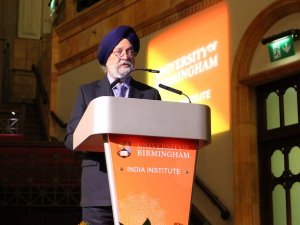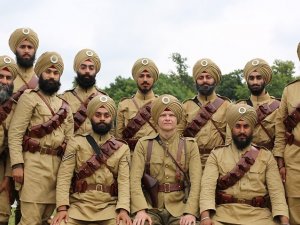In Guru Tegh Bahadur (1621-1675), the Sikhs have a most remarkable story to tell the world torn apart by religious conflict. It is the story of a great saint martyr who gave his life for the religious freedom of all. It was in that sense that His martyrdom was described as unique by Guru Gobind Singh.
My quest for the True Story of the Guru started in April 2016. Much that has been written about Him is based on Mughal court reports and Persian sources or influenced by anti-Sikhi, life-negating asceticism. Historians of the National Council of Educational Research and Training (NCERT) of India, have written highly biased accounts. The Sikh Missionary Society UK, asked me to sift through sources and present a coherent picture of Guru Ji’s life and mission. It took about one year and the study was published as “Guru Tegh Bahadur, The True Story” in 2017.
He was the youngest son of Nanak VI, Guru Hargobind (Guruship 1606-1644) and spent the first 23 years of his life in the loving company of his Father-Guru. Those years prepared him for his mission. He influenced the direction of Sikh affairs during four Guruships and laid the foundation for the final phase of the emergence of the Khalsa under Nanak X, Guru Gobind Singh (Guruship 1675-1708).
The spiritual and socio-political awakening in India found expression through the Bhakti movement. The liberalising spiritual message of the Bhagats from diverse backgrounds was made available to the masses through local languages.
Guru Nanak Sahib (1469-1539) further revolutionised the movement. He added clarity and new meanings to popular Bhakti idiom and allegory. Human soul-bride love and longing was unambiguously directed towards One Ajoni (Ajanma = beyond birth) Lord of all. Vedic Trimurti and incarnations, complex rituals, cults, caste and sex based hierarchical societal divisions, and all excuses for discrimination were rejected.
Nanaks I to X, gave organisation and lasting institutions to the Sikh Panth. The network of Guru’s sangats covered much of the Indian subcontinent and beyond. These sangats and the daswandh (tithe) system for social activism, ensured survival and continuity of the Sikh struggle against authoritarian rulers and the corrupt priestly class. Sangat networks of Guru Nanak were further revived and strengthened in northern India by Guru Tegh Bahadar.
All that unfolded after Guru Nanak was there in embryonic state in His ideology and implemented over the Guru period (1469-1708). By the time of Nanak V, Guru Arjan Dev (Guruship 1581-1606), with the institution of Aad Granth at Darbar Sahib, the foundational structure of the Sikh Panth was ready for the next phase. The trigger for that phase was the martyrdom of Guru Arjan.
The twin-track temporal and spiritual (miri-piri) way of Sikhi life introduced by Guru Nanak, was taken to the next stage by Nanak VI, Guru Hargobind. It becomes clear after connecting the dots in Guru-history, that Guru Hargobind was the main architect of the strategy which was followed by later Guru persons including Tegh Bahadur, first as Baba (title for Guru’s son) of Bakala and later as Nanak IX (Guruship 1664-1675).
Time for armed defence of Guru Nanak’s egalitarian ideology had come as a last resort. Sikh martyrdom (shaheedi) tradition started by Guru Arjan, gave birth to the ultimate warrior: one who conquers self and fear of death to witness the truth of own cause to the end. Such a concept was new to the Indian tradition. The martyrdoms of Guru Arjan and Guru Tegh Bahadur, empowered the Sikhi movement to lead the popular freedom struggle.
Guru Tegh Bahadur showed them the way to free themselves through total faith in the Creator Being: to fear none and be frightened by no-one. The inevitability of death is a central theme of His Bani. He offers freedom from fear of death and hope to those in helpless situations. All Bani of the Guru needs to be understood in that context, bearing in mind the pitiful condition of the Indian society at the time. The detachment preached in His Bani has to be understood as the pre-condition to a fearless disposition to be able to do one’s duty in life. It is not a message of despair which preaches opting out of society like earlier Indian belief systems. In fact, the Guru shows the falsehood of such life-negating ideologies.
Together with evidence from Bhatt Vahis and Assamese Buranjis (chronicles), the True Story of Guru Tegh Bahadur’s life, mission and martyrdom, begins to emerge. The Buranjis refer to the complaints by the Muslim ulema and Brahmin priests to the Mughal emperor against the preaching tours of Guru Tegh Bahadur which started in 1656, 10 years before His Guruship.
Lohgarh Fort (Haryana) discovery adds another important dimension to the study of this period. The fort was built under the supervision of Guru Har Rai, from about 1645 to 1657, by Lakhi Rai Vanjara (1580-1680), a Sikh of Guru Hargobind. At that Fort, the Guru had established a factory to manufacture weapons. These arms were manufactured by the Sikligars and the Vanjara Rajputs. Such, strengthening of Sikh facilities and organisation was low profile and did not attract too much Mughal attention. The latter were certainly not prepared for Baba Banda Singh Bahadur who took over Panjab in a very short time and defied the Mughal might for many years.
Thus, contrary to traditional understanding, Guru Tegh Bahadur’s period was of intensive preparation for armed defence against the increasingly authoritarian Mughal rule.
The Mughal emperors as directed by the ulema (Islamic scholars), were looking for ways to destroy the Sikh movement started by Guru Nanak. Then, there was the enemy within, the Brahmin, who felt threatened by the egalitarian social revolution of Guru Nanak. However, intercessions by influential Hindu, and Muslim friends of the Gurus delayed the inevitable final confrontation between the emperors at Delhi and the Gurus
Before His departure for Sach Khand, Guru Hargobind apprised Baba Tegh Bahadur, then 23 years old, of His mission. He was instructed to take His mother, Mata Nanaki, and wife, Gujri, to village Bakala. There He settled down to prepare for the next phase of his life. He remained active and Sangats visiting the Guru at Kiratpur would also visit Baba Tegh Bahadur at Bakala.
His life-style was saintly, yet stately. Like his Father-Guru, Hargobind, he was a trained saint-warrior. He took care of weapons as a matter of daily routine and kept up his interest in horse-riding and hunting.
Some facts about dates and events are as follows:
- According to Bhat Vahis, before His demise, Guru Har Krishan actually named “Tegh Bahadur, His Baba at Bakala” as the next Guru.
- Guruship was pass on to Baba Tegh Bahadur at an open well-attended ceremony led by Mata Sulakhni (Guru Harkishan’s mother) on 11 August 1664 at Bakala. There are references to this delegation in Bhatt Vahi Taolanda Pargana Jind and other sources. Other prominent Sikhs were also called to Bakala. This was two months before the arrival of Makhan Shah Lubhana at Divali festival on 9 October 1664. Makhan Shah played a critical role during the first phase of Guru Tegh Bahadur’s Guruship and came to Bakala with a small force to serve the Guru for some months.
- Contemporary sources confirm that Baba and later Guru, Tegh Bahadur, was the most travelled Guru after Guru Nanak. In consultation with Guru Har Rai, his preaching tours started in 1656, well before his Guruship. Therefore, the suggestion that he was meditating at Bakala for 20 (some say 26 or more) years, cannot be possibly true.
- The Brahmins, despite their earlier complaints about Guru Tegh Bahadur’s preaching tours, were desperate. They had seen over the centuries that while they could mislead the ordinary people with Vedic mythology and mantras, the invaders from the North-West were not impressed by such practices nor stopped by the magic spells. However, the Brahmins were well aware of the great influence of Guru Nanak, the Guru of the Hindus and the Pir of the Muslims, and the later Gurus. Guru Nanak, Guru Har Gobind and Guru Har Rai, had visited the valley of Kashmir and there were Sikh sangats in the area. Influential devotees of the Gurus, Sikhs like the trader, Makhan Shah Lubhana, were from Kashmir. In desperation and unable to invoke their numerous gods and goddesses, one leading Pandit made it known that in a dream he had been told by Lord Shiva to go to Nanak IX, Guru Tegh Bahadur for protection. Thus, Kashmiri Brahmins linked to Guru-Ghar, led the deputation to seek the Guru’s help.
- Aurangzeb was at Delhi when he, personally, ordered the execution of Guru Tegh Bahadur. Based on Guru Gobind Singh’s own testimony and also correction of the confusion of Hijri dates during Aurungzeb’s time , most writers are now agreed that Aurungzeb himself was at Delhi when the Guru was taken there.
- Guru Gobind Singh was born on Wednesday, 18 December 1661 (Julian Calendar). Evidence of Sakhi number 14 in Guru Kian Sakhian is relevant in connection with this prolonged tour..
- Guru Tegh Bahadur was arrested three times. His third arrest was from Malikpur Ranghran near Sirhind on 12 July 1675, and not from Agra as confused by some historians with His second arrest from Agra.
- Delhi Sikhs played a daring and well-planned part following Guru Tegh Bahadur’s martyrdom.
The above are some pointers to further research as we commemorate the 350th Anniversary of Guru Tegh Bahadur’s martyrdom to stabilize the world (Bhai Gurdas II Vaar 41.23)






